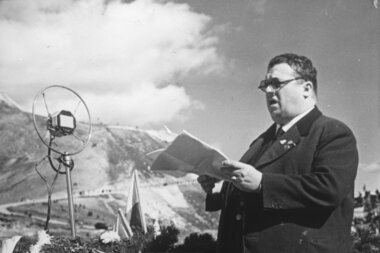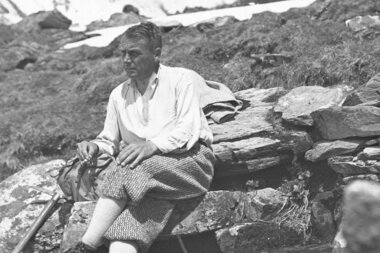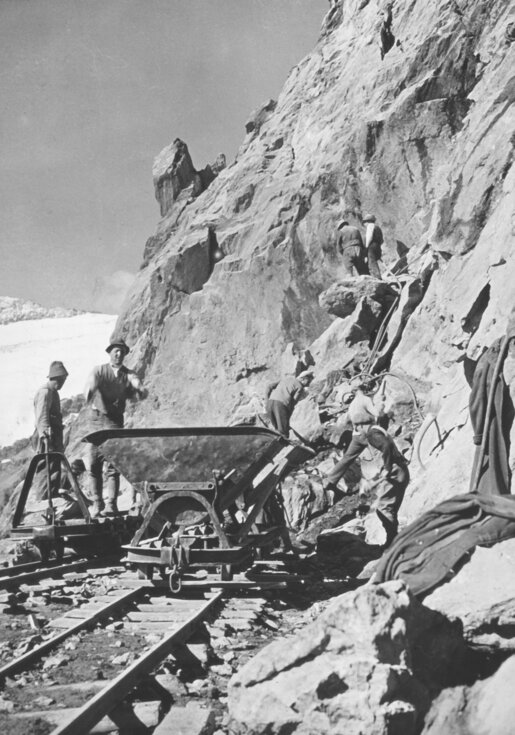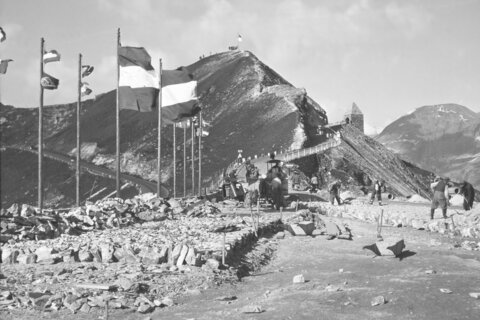Historic Monument From dangerous trade route to view-packed, adventure-filled road
Even 3500 years ago, people dared to tackle the path via the 2504m Hochtor. Celts and Romans used the shortest north-south link to trade goods. After all, the path via the Tauern was the shortest trade route between Germany in the north and the world trading hub of Venice in the south. Trade continued throughout the centuries – from the south came prized goods such as spices, fabrics and precious gems; while the north provided metal and furs. However, the route via the Alpine pass was exceptionally dangerous. The long hike and unpredictable changes in weather, together with snowfall and cold snaps cost many a hiker’s life. Little wonder then that people called upon the gods on the Hochtor to be kind to them.
Good reasons for ‘Project High Alpine Road’
There were several reasons behind the ‘Project Grossglocknerstrasse’ concept. The Habsburg Empire had just fragmented and the Republic of Austria, which was still in its early days, was looking for projects to give this state - which nobody really thought would be a success - a new sense of identity. In addition, unemployment was high. A construction site of the scale of the High Alpine Road would create thousands of jobs. A third reason was burgeoning tourism. The spectacular panoramic road would generate income through toll fees and holiday stays. Having your own car was considered a luxury which was the reserve of the wealthy. The hope was to do good business with these people.
From vision to construction
of the Grossglockner High Alpine RoadIt was thanks to the assertiveness of the then state governor Franz Rehrl and the superb planning of young construction engineer Franz Wallack that the Grossglockner High Alpine Road project was actually implemented. A new north-south connection, work for up to 4000 men and the prospect of lucrative business deals ensured that on 30th August 1930 the first blasting heralded the construction of the Alpine Road. Having overcome numerous obstacles, just five years later, on 3rd August 1935 the Grossglockner High Alpine Road was inaugurated by Austrian president Wilhelm Miklas. The very next day the first car race was held on the road, which was still covered with sand. Also present were state governor Rehrl and engineer Wallack! A memorial site on Fuscher Törl is dedicated to all the workers who lost their lives during the construction of the road.

Privy councillor Dr. Franz Rehrl – Salzburg state governor (1922-1938)
Salzburg’s state governor Franz Rehrl (1890-1947) is regarded as being the driving political force behind the construction of the Grossglockner High Alpine Road. He was also an avid automobile fan. He had set his mind on being the first person to cross the Hohe Tauern in a car. And so, on 22nd September 1934 he sat at the wheel of a converted Steyr 100, accompanied by road building engineer Franz Wallack, on the skeleton construction work that was to become the Grossglockner High Alpine Road, heading for the Hochtor. This breakneck drive via the Hochtor to Heiligenblut and back again lasted some seven hours!

Franz Wallack – Engineer & Visionary (1887–1966)
Franz Wallack had a vision of a panoramic road that would be in harmony with the high mountain landscape. And so it was that the road planner, who is depicted in many photos and pictures wearing bright knee breeches and a sports jacket with an orange knit necktie, reconnoitred 30 Alpine pass roads and 13 main Alpine crossings as part of a recce over just five weeks in the summer of 1925. He wanted to get to know the roads for himself, see with his own eyes how they were constructed and embedded in the landscape and find out which constructions supported them. The aim was that the Grossglockner High Alpine Road would shine as the ‘brightest star’ of all Europe’s Alpine roads. And we would say: mission complete!
Development of the road to become a visitor magnet
It was not just goods traffic, but tourism too, that helped this north-south link enjoy speedy success! One of the most superb high Alpine landscapes in Europe was suddenly accessible to everyone. During the ‘economic miracle’ years, motorisation increased and having one’s own car became a matter of course. The road’s 48 kilometres and 36 bends were widened and extended, while parking areas, gastronomic and accommodation service providers, contemporary exhibitions and adventure paths today guarantee a unique experience in the heart of the Alps for around a million visitors every year. Today this unique mountain road, along with Schönbrunn Palace and Hohensalzburg Fortress, is one of the top 3 sights in Austria!
Experience Archaeology
‘Passheiligtum Hochtor’ exhibitionIn spite of all the dangers, trade continued across the dangerous north-south route for a long time. Today the ‘Passheiligtum Hochtor’ exhibition’ right next to the south portal of the Hochtor whisks you off on a journey through the millennia. The exhibition tells of offerings presented for a good journey, of gods and demi-gods, of the search for mountain crystal, of gold mines, and also of human trafficking via the pass. Incidentally, just as for all the exhibitions along the Grossglockner High Alpine Road your visit to the ‘Passheiligtum Hochtor’ is free of charge!

Living contemporary history
‘Bau der Straße’ (construction of the road) exhibition at Fuscher LackeIn the road maintenance workers’ booth at Fuscher Lacke, which is still in its original from from the time the road was being constructed, is the permanent exhibition ‘Bau der Straße’. This shows the tough conditions more than 4000 road workers had to endure, along with social achievements including the first bad weather regulation in Austria. After all, without these so-called ‘Glocknerbaraber’, the ideas of Wallack and Rehrl would have remained a mere pipe dream. Absolutely worth seeing the exhibition film ‘Grossglockner High Alpine Road – The power of a vision’, awarded the Gold Dolphin in Cannes!




